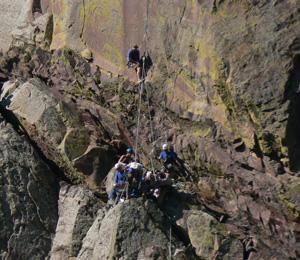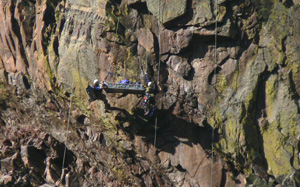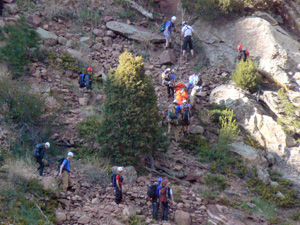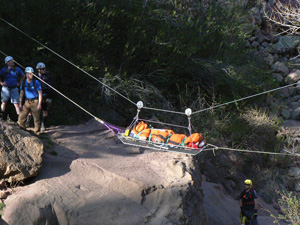|
|

Accident Analysis and Rescue Reports
The April 27, 2008 - Rescue of an injured climber from the Redgarden Wall
On the afternoon of April 27, 2008,
Boulder County dispatch notified RMRG of an injured climber in need of assistance
on
Redgarden Wall in
Eldorado Canyon State Park ("Eldo"). The ensuing rescue took four and a
half hours, involved dozens of rescuers from numerous agencies, and multiple
discrete operations (including vertical-, scree-, and Tyrolean-style evacuations).
Events Leading to the Accident
Two experienced climbers were attempting to climb the first pitch of the
Doub-Griffith route, a difficult technical
climb that starts from a small ledge, 150 feet above the base of Redgarden Wall.
As the leader was climbing he inadvertently pulled a large, table-sized flake free
from the wall. Both he and the flake fell. The large rock landed on the belayer who
was sitting on the ledge below. Using an auto-locking belay device (Cinch) the belayer stopped the
leader's fall. Both the leader and the belayer sustained injuries. Although
the leader was able to get to the ground and walk out on his own, the belayer
was incapacitated by his injuries.
Initial response
Absent a street address, initial dispatch information rarely pinpoints
the exact location of an accident scene. At the time rescuers arrived in the park
we knew only that an accident had occurred on Redgarden Wall, a large cliff.
Since we did not have a name of a particular climbing route or any
more specific information on the location of the injured party, we initiated a
search. Some rescuers went up along the west face of Redgarden Wall; other rescuers
went toward the East Slabs descent route; still other rescuers went to the Fowler
Trail with binoculars to try to locate signs of the accident scene. Within about
10 minutes we established that the injured party was still on the cliff, about
150 feet above the base and near the start of the
Doub-Griffith rock climbing route.
Vertical Evacuation
For many rescues it is obvious how to best access the patient.

Rescuers loading patient into litter before vertical evacuation click to enlarge
However, for
a patient located in the middle of a cliff, the best access route might be
from above, below, or traversing from the same elevation. It may be fastest
to send medical personnel with light loads up from the ground while other rescuers carry
the heavier
evacuation gear (litter, full-body vacuum
splint, 400-1600 feet of rope, anchor
and brake equipment, additional oxygen, etc.) around to an easier access
route from the top (potentially via the East Slabs descent route). We are quite
familiar with using both approaches on various portions of Redgarden Wall.
However, the Redgarden Wall is a big formation and small changes in the location of
the injured party can drastically effect rescue access and the evacuation route. Therefore,
we generally investigate and fix lines for all options until the best solution can be
determined.
In this case, the first RMRG rescuer was able to access the patient from
below by rope ascending 150 feet on a bystander climber's fixed line. The rescuer quickly
assessed the patient's injuries, provided
first aid, and established that it was possible to build a rescue anchor near
his location. Rescuer observers from various perspectives collaboratively decided that
it would be fastest to have additional rescuers haul evacuation gear up to the
patient from below.
In just over an hour from the time RMRG was notified, rescuers had driven
to the park, organized the required rescue gear, located the accident at the
start of Doub-Griffith, hiked to the base of the climb, and ascended 150-feet
of fixed rope to reach the patient.
Ultimately RMRG had five personnel on the small (3 x 4-foot) ledge: a paramedic
to provide continuous medical care and four rescuers to prepare for a vertical evacuation.

Vertical lowering of patient in litter click to enlarge
The evacuation required building a mid-wall anchor appropriate for rescue
use. Although standard rock protection equipment was used, rescue anchors undergo
significantly higher working loads and different loading characteristics than
standard climbing anchors. The anchor was set up well above the ledge so that
a brakeman could manage the ropes and braking system while hanging from the anchor,
thereby optimizing the limited space on the ledge. In the meantime, all the gear
required to "package" the patient for his transport down the cliff face was either
hauled up to the ledge or carried on the backs of rescuers as they ascended the
fixed ropes.
A safe
vertical evacuation is gear- and personnel-intensive. In this case
the anchor was more complicated than usual. Non-RMRG bystander climbers provided
invaluable help on and above the patient's ledge.
When everything was prepared, rescuers loaded the patient into the litter.
The loading process is critical for patient care, and is therefore done carefully and
methodically. Moving a patient without aggravating broken limbs or spinal injuries
is difficult on flat ground, and much more difficult on a 3-foot wide ledge.
After the patient was safely in the litter, rescuers secured him for the ride down.
The loading started just over two hours after rescuers reached the scene, and the vertical
litter lowering was completed in a couple of minutes.
Scree Evacuation
While the rescuers on the cliff prepared for and completed the vertical evacuation,
a second team of rescuers prepared to transition the patient to the subsequent
scree evacuation. The scree evacuation is a standard rescue
technique and is the safest and fastest way to move a litter-borne patient from
the base of Redgarden Wall down to South Boulder Creek. (See FAQ2
and FAQ3 on our
Operational FAQ page for more information on this evacuation technique.)
The fall-line path down the gulley below Redgarden Wall requires three or more pitches of lowering on a 200-foot rope, and reaches the
Streamside Trail roughly
a quarter mile upstream of the footbridge at the
Whale's Tail.

Scree lowering patient in litter (orange, middle) click to enlarge
Approximately ten RMRG rescuers and ten personnel from other agencies were
in position at the base of Redgarden Wall below the accident site. Some of these
rescuers worked in support roles for the mid-wall activities, managing
ropes and gear from the ground. Others prepared the scree evacuation
route. The entire route was scouted for potential hazards, and multiple belay (lowering)
stations were pre-set. Additional rescuers were in position down-slope anticipating the possibility of
relieving litter bearers during the scree evacuation.
A litter team of six rescuers received the patient from the vertical evacuation,
and immediately began transitioning the litter rigging into a scree-evacuation
configuration. These adjustments must be made because the litter-borne patient is kept horizontal
throughout the vertical evacuation, but then is tilted
head-up/feet-down for the scree evacuation. An RMRG member who is also an emergency-room
physician was waiting at the base of the cliff and provided additional and nearly-continuous
medical care throughout the scree evacuation.
In some circumstances scree evacuations go quickly. However, because of
the significant and unavoidable rock-fall hazards along and below the Redgarden Wall,
scree evacuations in this area proceed cautiously. During this particular scree
evacuation at least two bowling ball-sized rocks were inadvertently knocked
loose and rolled downhill, one ultimately reaching the creek. This is a dangerous
but inescapable aspect of evacuations from the base of Redgarden Wall.
Tyrolean traverse
While rescuers worked on the ledge and prepared for the scree evacuation,

Lifting litter-borne patient across the creek with a wire Tyrolean traverse - click to enlarge
another team of rescuers built a Tyrolean ("Tyrol") traverse system to lift
the patient across South Boulder Creek. RMRG chose to use the Tyrolean crossing for
several reasons. Because the creek was high, litter bearers wading with the litter was
not an option. That left a choice between carrying the patient along the
Streamside Trail to the footbridge, or using the Tyrol. In most cases
when RMRG evacuates a litter-borne patient from the western portion of the
Redgarden Wall, the Tyrol is significantly
faster, safer, and more comfortable for the patient. For more
on this, please see FAQ6 on our
Operational FAQ page.
Upon reaching the creek, the patient was transferred to the Tyrol and quickly
transported across to the road, arriving at the ambulance about 45 minutes
after the scree evacuation had begun. The ambulance transported the patient
to the Rocky Mountain
Fire Authority (RMFA) station on Eldorado Springs Drive where
it met an Air Life helicopter ambulance.
Conclusions
Loose rock is a hazard in
most climbing areas, even on routes that are well established. Weather, seasonal and daily
freeze-thaw cycles erode rock and loosen holds. Inspecting and/or gently testing
suspect holds before pulling forcefully on them reduces the chance of holds
breaking loose and possible subsequent falls. In this case, previous climbers had warned
of loose rock on a local climbing web forum (MountainProject.com) and had suggested its removal.
Despite painful injuries, the injured belayer-climber stopped
the leader's fall, and successfully lowered the leader back to the belayer's ledge.
The auto-locking feature of the belay device probably assisted in stopping the leader's fall. Prudent
climbing leaders will have the equipment (prusik cords) and skills to escape from hanging
on a taut rope in the event the belayer is unable to lower the leader due to
belayer incapacitation or insufficient remaining rope.
Additionally, wearing a helmet is a prudent habit and can reduce climbers' chances of injury from falling rocks, and from injuries due to impacting the wall during a fall.
RMRG would like to thank all those who assisted in this rescue. This mission
was a great example of many individuals and agencies coming together to assist
an injured climber. In addition to 30+ RMRG members, visitors from three other
mountain rescue groups (in Boulder for joint training with RMRG), personnel from
Rocky Mountain Fire Authority, Boulder County Sheriff's Office, Boulder Emergency Squad
(swiftwater support), the Red Cross (logistical support), Colorado State Parks,
bystander climbers, and Air Life all assisted in this rescue.
As with all of our operations, we always learn from our experiences and strive
to make each future rescue more efficient and effective than the last. If we
can clarify any further questions please
contact us.
|
|








 Rescuers loading patient into litter before vertical evacuation
Rescuers loading patient into litter before vertical evacuation Vertical lowering of patient in litter
Vertical lowering of patient in litter Scree lowering patient in litter (orange, middle)
Scree lowering patient in litter (orange, middle)  Lifting litter-borne patient across the creek with a wire Tyrolean traverse - click to enlarge
Lifting litter-borne patient across the creek with a wire Tyrolean traverse - click to enlarge







